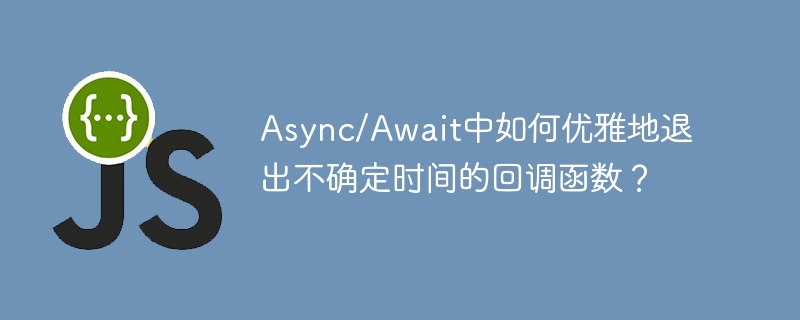Async/Await中如何优雅地退出不确定时间的回调函数?

如何使用 async await 退出不确定时间的回调函数?
在使用 async await 编写异步代码时,有时会出现需要从不确定时间的回调函数中退出的情况。通常情况下,常规的 promise 写法可以使用 then() 链式调用来退出,但 async await 写法没有直接的退出方式。
例如,如下代码中的函数 a 使用 promise 写法,其中回调函数 callback 可以监听按钮属性的变化,并通过 resolve() 触发退出函数:
const a = (): promise<void> => { return new promise((resolve) => { const callback = (mutations: mutationrecord[]) => { // 监听按钮的某个属性变化,此处退出函数 resolve(); }; const observer = new mutationobserver(callback); observer.observe(buttonel, { attributes: true, }); // 调用一个 promise 函数,成功后触发按钮的点击事件,然后监听按钮的属性变化 p().then(() => { buttonel.click(); }); }); };
然而,如果将 a 函数改写成 async await 写法(即函数 b),就无法直接通过 resolve() 来退出回调函数:
const b = async (): promise<void> => { const callback = (mutations: mutationrecord[]) => { // 监听按钮的某个属性变化,怎么在此处退出函数? }; const observer = new mutationobserver(callback); observer.observe(buttonel, { attributes: true, }); // 调用一个 promise 函数,成功后触发按钮的点击事件,然后监听按钮的属性变化 await p(); buttonel.click(); };
针对上述问题,目前可以采用比较新的 promise.withresolvers() 接口来实现退出。该接口处于 stage-4 阶段,它可以创建一个 promise,并提供对应的 resolve 和 reject 回调函数:
const b = async (): Promise<void> => { const { promise, resolve } = Promise.withResolvers<void>() const callback = (mutations: MutationRecord[]) => { resolve(); }; const observer = new MutationObserver(callback); observer.observe(buttonEl, { attributes: true, }); // 调用一个 Promise 函数,成功后触发按钮的点击事件,然后监听按钮的属性变化 await p(); buttonEl.click(); // 下面这句也可以用 return promise,取决于你的后续逻辑 await promise };
使用 promise.withresolvers() 接口,可以在回调函数中通过调用 resolve() 来触发 promise 的完成。这样就实现了从不确定时间的回调函数中退出 async await 函数的目的。
需要注意的是,promise.withresolvers() 接口目前尚未得到广泛支持,如果你需要兼容旧的浏览器,可能需要更新 core-js。此外,如果你使用了 typescript,需要将 ts 更新到 5.4 或以上,并在 tsconfig.json 文件中确保 lib 选项包含 esnext。
以上就是Async/Await中如何优雅地退出不确定时间的回调函数?的详细内容,更多请关注硕下网其它相关文章!
